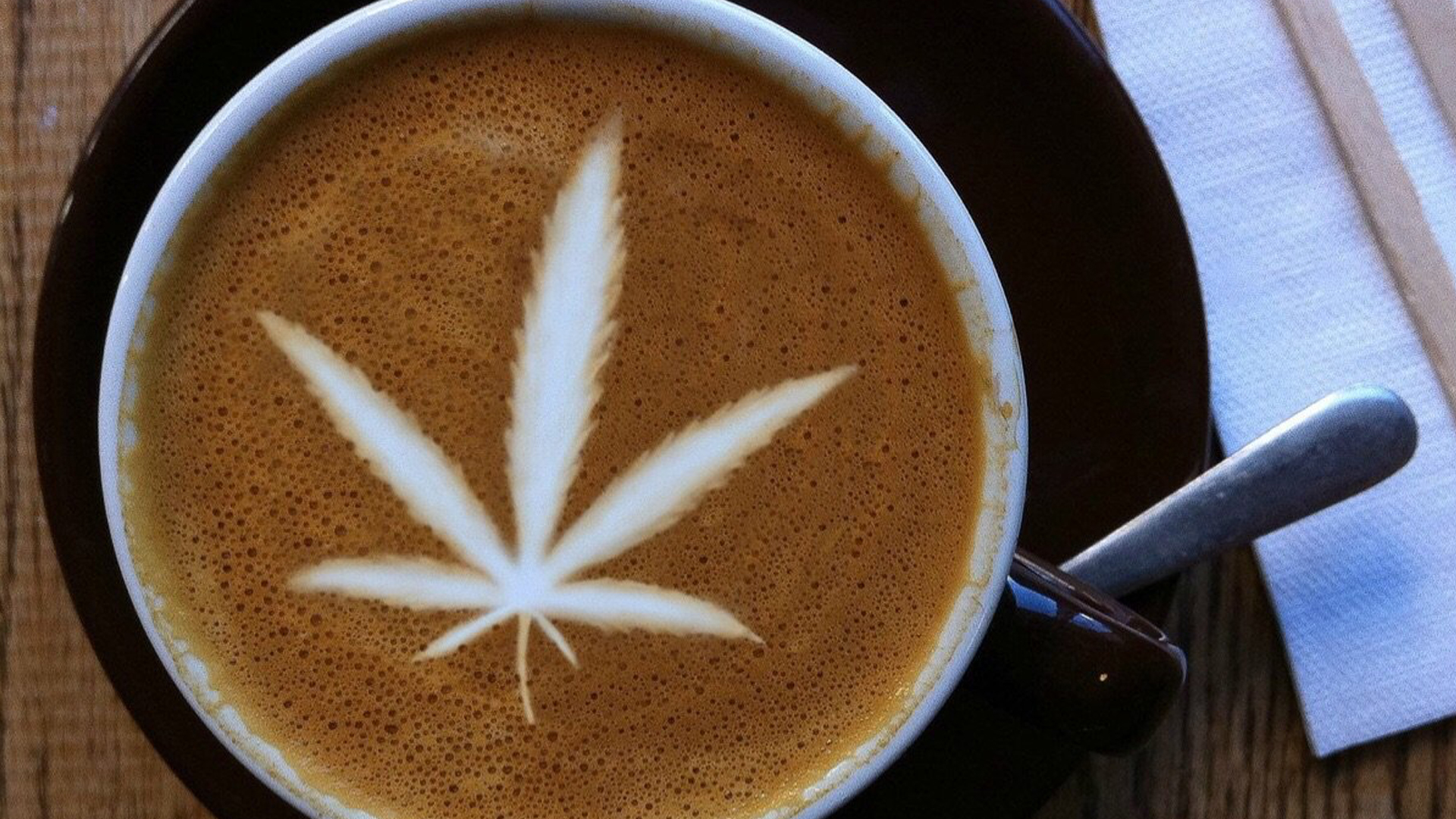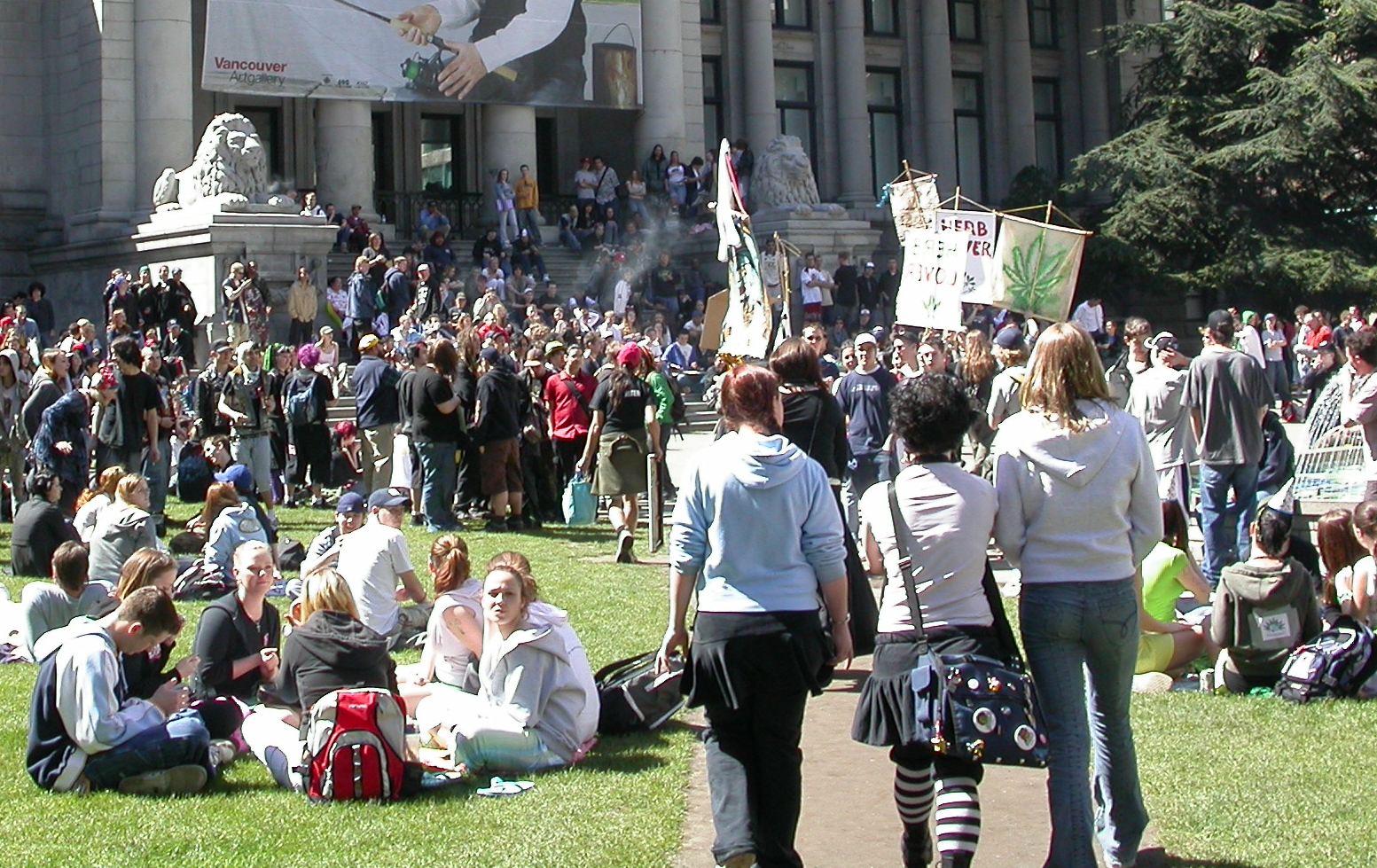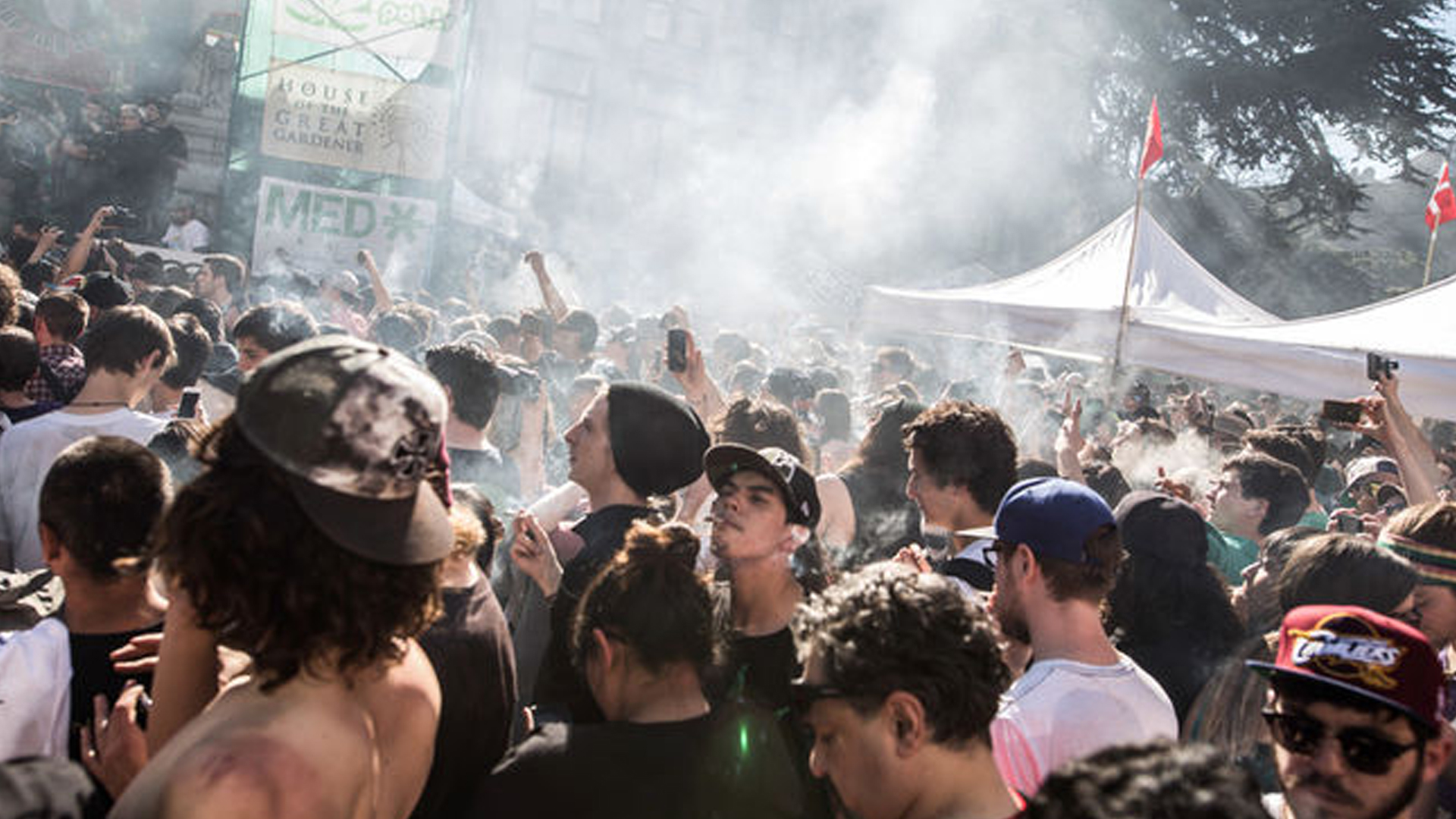Cannabis vs Caffeine: Which is Safer, a Cup of Coffee or a Puff of Weed?

CANNABIS CULTURE – “In wise hands poison is medicine. In foolish hands medicine is poison.” – Casanova
A POPULAR DRUG
Like most drugs, this one goes by many names. In the world of science, it’s sometimes called “Theine” or “Guaranine” or “Methyltheobromine”. On the street, it’s called an “upper” or “stimulant” or “pep pill” or “candy bar” or “headache pill” or “hot beverage” or “soft drink”. Like sugar and alcohol, it’s more often considered a food than a medicine.
It is caffeine – the world’s second most popular psychoactive substance – second only to sugar. Global consumption of caffeine has been estimated at 120,000 tonnes per year, which amounts to one caffeinated beverage for every person on earth, every day.
Caffeine occurs naturally in over 60 plants found all over the world. People have been drinking caffeinated beverages such as coffee for well over 1000 years. Legend has it that tea has been drunk for over 4000 years. And chocolate – which also contains a little bit of caffeine – has been around for nearly 4000 years as well – and became popular with the Europeans in the 1500s, as soon as they tasted it.
These days caffeine has been isolated from its botanical origins and can also come in a white powder similar to cocaine. It is also found in pep pills, diet pills, and headache medicine.
Caffeine is in headache medicine because you get a headache when you withdraw from caffeine. When you stop using abruptly, you feel icky – and most often you get a headache. So they put caffeine in headache medicine because humans are often caffeine junkies and the headache medicine is “feeding their Jones” and “giving them a fix” – not because caffeine by itself is any good at curing headaches.
COMPARE TO CANNABIS
Contrast this with another popular soft drug – cannabis. Cannabis is the most popular “illegal” substance in the world. Just how popular is a bit tricky to estimate.
Because possession can sometimes lead to a long jail sentence, and trafficking can be – once in a while – a death sentence, global cannabis use statistics aren’t all that accurate or a true reflection of popularity. But official estimates of lifetime use can vary from 20% to 50% of the global population. Those that use more than once per month is closer to 10% to 30%, depending who and how you ask.
Cannabis has been used for many thousands of years as a medicine/sacrament, and as a source of food and textiles.
It is now being investigated as the source of hundreds if not thousands of new medicines, due to the hundreds of different cannabinoids and terpenes that are found in cannabis – none of which are toxic, and all of which are medically active.
Now that the most popular illegal drug is looking more and more legal every day, how does it compare and contrast with the most popular drug, in terms of effects and risks and the current costs to society?
THE EFFECTS
Caffeine is a stimulant. Stimulants are used to fight lethargy, reduce sleepiness, decrease appetite, and to help with concentration and focus.
Cannabis can also sometimes act as a stimulant, if the right strain and dose is taken. Cannabis can also be a relaxant, a time-slow-down performance-enhancing drug, and a medicine for many conditions due to the hundreds of different terpenes and cannbinoids found in the buds. Humans are just beginning to map out the strains and effects in order to realize cannabis’ true potential.
OVERDOSE RISK
Caffeine and cannabis are similarly low-risk drugs, but there are some important differences. The first is the risk of a lethal overdose.
Deaths from caffeine overdose are rare, but there’s a few every year. A lethal dose of caffeine for an adult is somewhere between 3,200 milligrams and 10,000mg at one time.
Your typical 8 ounce cup of coffee contains 80-180mg of caffeine. Energy drinks contain up to 357mg. Anti-sleep and diet medicines contain up to 300mg. A “Dunkin’ Donuts Coffee with Turbo Shot” contains 436mg. A box of “Crackheads2” coffee bean candies contains 600mg, and comes with a warning label – “one box per day”. Over six boxes at once could be dangerous for an adult.
Pure caffeine powder is sold in a box with 124 one gram packages. That’s 124,000 milligrams – over a dozen lethal overdoses in every package.
The number of people who die of caffeine overdoses is low, but it’s been increasing over the past several years with the advent of energy drinks. Some researchers argue that many heart attack deaths could actually be undiagnosed caffeine overdose deaths, making the actual death toll significantly higher.
To contrast this with cannabis, there have been zero confirmed overdose deaths from cannabis – ever.
However, an unpleasant experience can be felt with even a small dose of cannabis – especially if one is unfamiliar with the effects, if the body is stressed, or if the mind is unready to experience the effects.
Nearly every user will feel uncomfortable if enough edible cannabis products are ingested. Moderation is the key to avoiding unwanted effects. When cannabis is smoked, very small amounts can have an effect almost immediately, allowing for “self-titration” or dosing. This is not possible with orally ingested drugs such as caffeine.
OVERUSE DEATHS
Long-term caffeine use kills between 1,000 to 10,000 people every year in the US, from “stress, ulcers and triggering irregular heartbeats,” according to the US Bureau of Mortality Statistics.
Cannabis overuse deaths are, again, zero, according to the same source.
WITHDRAWAL SYMPTOMS
According to a report from the Royal College of Psychiatrists published in 2005, caffeine withdrawal symptoms include “headache, irritability, sleeplessness, confusion, nausea, anxiety, restlessness and tremor, palpitations and raised blood pressure. They are at their worst for 1–2 days, then recede.”
Headaches from caffeine withdrawal are considered “extremely common”.
With cannabis, “If people experience withdrawal symptoms at all, they are remarkably mild.” Typical cannabis withdrawal symptoms might include irritability and mild insomnia.
It has been my personal experience that you might miss no longer being relaxed, hungry and happy, but unlike caffeine, there is no such thing as an “extremely common” marijuana-withdrawal headache
Of course, when you’re using cannabis for a medical reason, those symptoms can return when you quit using cannabis. This isn’t a withdrawal effect, this is the result of taking away a helpful medicine.

“Experts Rate Problem Substances,” Daily World, Opelousas, Louisiana, August 9th, 1994, p. 5
IMPAIRMENT
The more common side effects of caffeine, especially in large doses, are: diarrhea, dizziness, fast heartbeat, hyperglycemia, blurred vision, drowsiness, flushed dry skin, ketones in urine, loss of appetite, nausea, stomach ache, tiredness, troubled breathing, vomiting, anxious feeling, cold sweats, confusion, shakiness, irritability.
In contrast, cannabis’ acute toxicity is low compared with that of any other drugs. The side effects of large doses involve cognitive impairment, psycho-motor impairment, anxiety, dysphoria, panic and paranoia.
The one area where cannabis is more risky than caffeine is in the impairment experienced by a novice user after a typical dose. This could effect what age limits, if any, are placed upon legal cannabis access.
COST TO SOCIETY
Evaluating the costs of cannabis and caffeine to society is not easy. Both the National Institute on Drug Abuse and the Canadian Center on Substance Abuse limit their research to tobacco, alcohol, and “illegal drugs.” They exclude pharmaceuticals, and caffeine.
When caffeine is seen as a drug rather than a food, and testing for caffeine after road accidents and premature death becomes standard, the true costs of caffeine abuse will one day be recorded.
Similarly, the costs of so-called “cannabis abuse” are often confused with the costs of “prohibition enforcement,” or with problems stemming from the lack of education around cannabis harm-reduction.
When cannabis is fully legalized for all users, and education in cannabis harm reduction becomes common, cannabis’ true cost to society can be fairly evaluated.
CONCLUSION
To conclude, caffeine is clearly more risky, more dangerous, more deadly, more harmful and more costly than cannabis in every category – overdose deaths, overuse deaths, withdrawal symptoms and acute toxicity.
The only area where cannabis provides the greater risk is in regards to the impairment levels of novice users.
Regulations that treat cannabis as far more dangerous than caffeine don’t reflect reality, and should be challenged by drug peace activists. Society should treat each drug according to the risks that drug provides, rather than making rules based on ignorant myths and racist, outdated traditions.
Sources of information for the facts found in this article:
Caffeine – The Most Popular Stimulant, from The Encyclopedia of Psychoactive Drugs, Richard Gilpert, Ph.D., Burke publishing, 1986, pp. 93-94
http://www.ncbi.nlm.nih.gov/pubmed/20170393
http://www.ncbi.nlm.nih.gov/pubmed/15935584
http://www.cspinet.org/new/cafchart.htm
http://www.caffeineinformer.com/a-real-life-death-by-caffeine
http://www.caffeineinformer.com/caffeinated-killers
http://www.dietitians.ca/Your-Health/Nutrition-A-Z/Caffeine/Food-Sources-of-Caffeine.aspx
http://www.cleveland.com/metro/index.ssf/2014/07/caffeine_overdose_deaths_rare.html
http://www.nytimes.com/2012/11/15/business/5-hour-energy-is-cited-in-13-death-reports.html
http://well.blogs.nytimes.com/2015/05/18/caffeine-powder-poses-deadly-risks-2/
http://www.huffingtonpost.com/2014/02/06/gemma-moss-marijuana-death_n_4738167.html
http://www.huffingtonpost.com/2014/02/28/marijuana-deaths_n_4868209.html
http://www.ccsa.ca/Eng/topics/Costs-of-Substance-Abuse-in-Canada/Pages/default.aspx
https://www.drugabuse.gov/related-topics/trends-statistics
http://www.hopkinsmedicine.org/psychiatry/research/BPRU/docs/Caffeine_Dependence_Fact_Sheet.pdf



